1995 BUICK REGAL run flat
[x] Cancel search: run flatPage 3 of 340
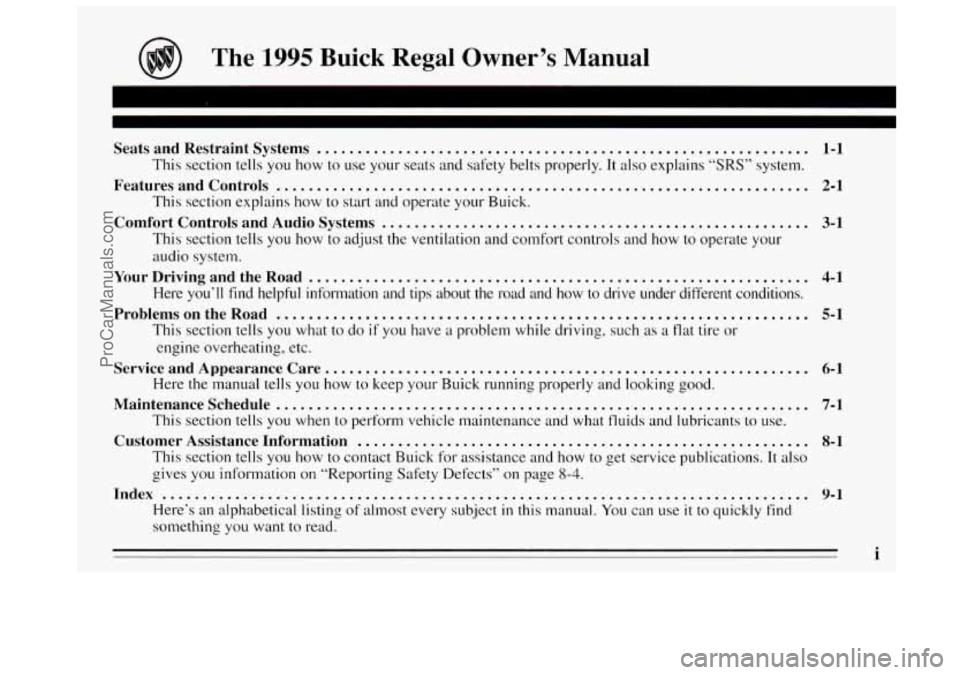
The 1995 Buick Regal Owner's Manual
I
Seats and Restraint Systems .............................................................
This section tells you how to use your seats and safety belts properly. It also explains "SRS" system.
Featuresandcontrols ..................................................................
This section explains how to start and operate your Buick.
Comfort Controls and Audio Systems .....................................................
This section tells you how to adjust the ventilation and comfort controls and how to operate your
audio system.
YourDrivingandtheRoad ..............................................................
Here y6u'll find helpful info]-mation and tips about the road and how to drive under dif-ferent conditions.
ProblemsontheRoad ..................................................................
This section tells you what to do if you have a problem while driving. such as a flat tire or
engine overheating. etc.
ServiceandAppearanceCare ............................................................
Here the manual tells you how to kccp your Buick running properly and looking good.
Maintenanceschedule ..................................................................
This section tells you when to perform vehicle maintenance and what fluids and lubricants to use.
Customer Assistance Information ........................................................
This section tells you how to contact Buick for assistance and how to get service publications. It also
gives you infortnation on "Reporting Safety Defects.' on page 8-4.
Index ........................................................................\
........
Here's an alphabetical listing of almost every sub.ject in this n1anual. You can use it to quickly find
something you want
to read.
1-1
2- 1
3-1
4- 1
5- 1
6- 1
7- 1
8- 1
9- 1
1
ProCarManuals.com
Page 99 of 340

Convenience Net (Option)
Your vehicle may have a convenience net. You’ll see it
on the back wall of the trunk.
Put small loads, like grocery bags, behind the net. It can
help keep them from falling over during sharp turns or
quick starts and
stops.
The net isn’t for larger, heavier loads. Store them in the
trunk as far forward as you can.
You can unhook the net so that it will lie flat when
you’re not using it.
Storage and Compartments
Storage Armrest
To use the storage area, fold
down the armrest. Press the
latch on the front edge and
pull
up. To use the
cupholder, flip it forward.
You may also have an
armrest in the rear. It may
have a storage area and
cupholders.
2-37
ProCarManuals.com
Page 164 of 340
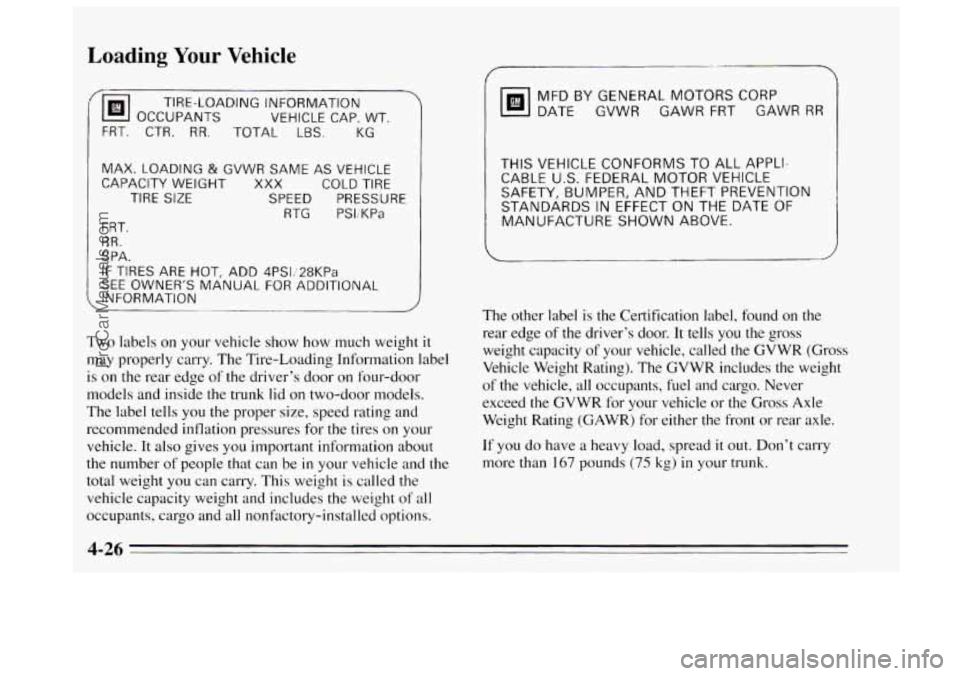
Loading Your Vehicle
OCCUPANTS VEHICLE CAP. WT.
TIRE-LOADING INFORMATION
I FRT. CTR. RR.
TOTAL LBS. KG
MAX.
LOADING & GVWR SAME AS VEHICLE
CAPACITY WEIGHT XXX COLD TIRE
TIRE
SIZE SPEED PRESSURE
RTG
PSIiKPa
FRT.
RR.
SPA.
IF TIRES ARE HOT, ADD 4PSIj28KPa
SEE OWNER’S MANUAL FOR ADDITIONAL
INFORMATION
- ~-__I__-__ -d
Two labels on your vehicle show how much weight it
may properly carry. The Tire-Loading Information label
is on the rear edge of the driver’s door on four-door
models and inside the trunk lid on two-door models.
The label tells you the proper size, speed rating and
recommended inflation pressures for the tires on your
vehicle. It
also gives you important information about
the number of people that can be
in your vehicle and the
total weight you can carry. This weight is called the
vehicle capacity weight and includes the weight of
all
occupants, cargo and all nonfactory-installed options.
/ -- -7
MFD BY GENERAL MOTORS CORP
DATE GVWR GAWR FRT GAWR RR
I
THIS VEHICLE CONFORMS TO ALL APPLI-
CABLE
U.S. FEDERAL MOTOR VEHICLE
SAFETY,
BUMPER, AND THEFT PREVENTION
STANDARDS
IN EFFECT ON THE DATE OF
MANUFACTURE SHOWN ABOVE.
1
The other label is the Certification label, found on the
rear edge of the driver’s door. It tells you the gross
weight capacity of your vehicle, called the GVWR
(Gross
Vehicle Weight Rating). The GVWR includes the weight
of the vehicle, all occupants, fuel and cargo. Never
exceed the GVWR for your vehicle or the Gross Axle
Weight Rating (GAWR) for either the front or rear axle.
If you do have a heavy load, spread
it out. Don’t carry
more than
167 pounds (75 kg) in your trunk.
4-26
ProCarManuals.com
Page 168 of 340
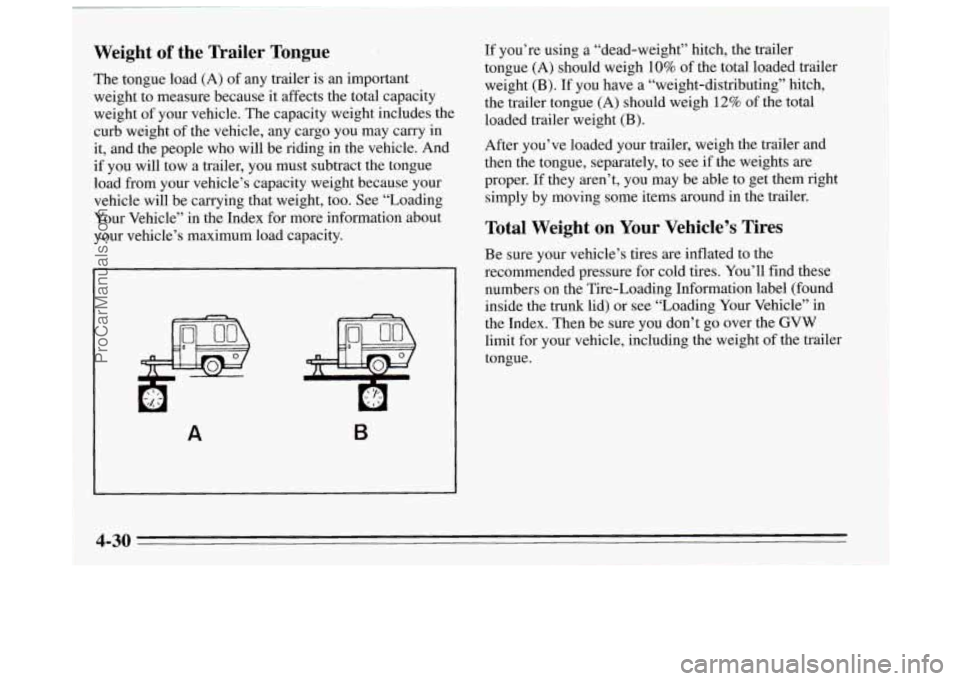
Weight of the Trailer Tongue
The tongue load (A) of any trailer is an important
weight to measure because it affects the total capacity
weight of your vehicle. The capacity weight includes the
curb weight of the vehicle, any cargo you may carry in
it, and the people who will be riding in the vehicle. And
if you will tow a trailer, you must subtract the tongue
load from your vehicle’s capacity weight because your
vehicle will be carrying that weight, too. See “Loading
Your Vehicle” in the Index for more information about
your vehicle’s maximum load capacity.
A B
If you’re using a “dead-weight” hitch, the trailer
tongue (A) should weigh
10% of the total loaded trailer
weight
(B). If you have a “weight-distributing” hitch,
the trailer tongue
(A) should weigh 12% of the total
loaded trailer weight (B).
After you’ve loaded your trailer, weigh the trailer and
then the tongue, separately, to see if the weights
are
proper. If they aren’t, you may be able to get them right
simply by moving some items around in the trailer.
Total Weight on Your Vehicle’s Tires
Be sure your vehicle’s tires are inflated to the
recommended pressure for cold tires. You’ll find these
numbers on the Tire-Loading Information label (found
inside the trunk lid) or see “Loading Your Vehicle” in
the Index. Then be sure you don’t go over the
GVW
limit for your vehicle, including the weight of the trailer
tongue.
4-30
ProCarManuals.com
Page 204 of 340
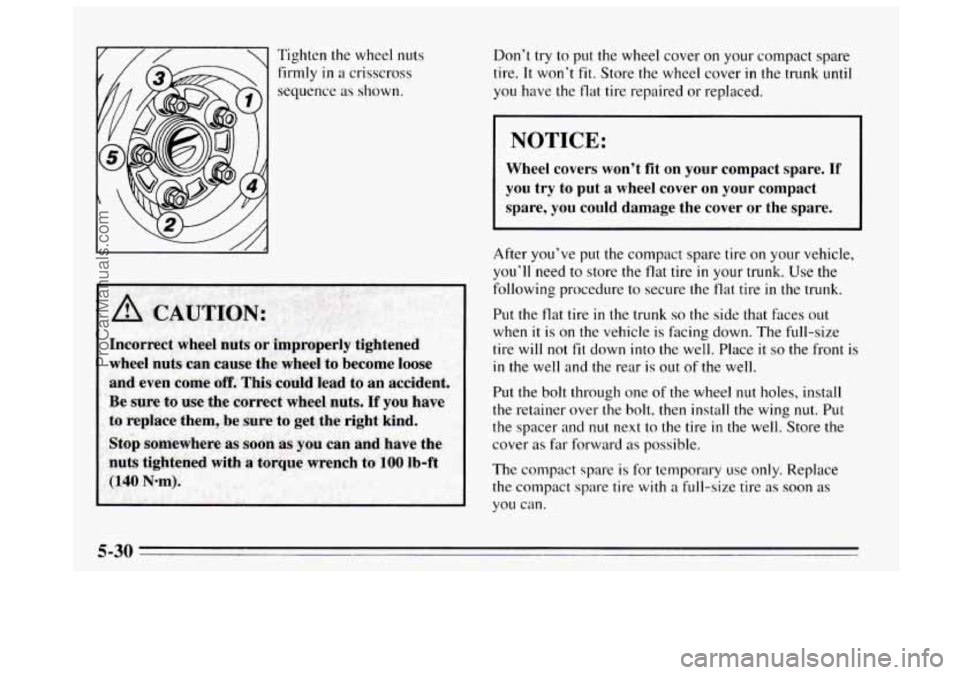
Tighten the wheel nuts firmly
in a crisscross
sequence as shown. Don’t
try
to put the wheel cover on your compact spare
tire. It won’t
fit. Store the wheel cover in the trunk until
you have the flat tire repaired or replaced.
I NOTICE:
Wheel covers won’t fit on your compact spare. If
you try to put a wheel cover on your compact
spare, you could damage the cover or the spare.
After you’ve put the compact spare tire on your vehicle,
you’ll need to store the flat tire
in your trunk. Use the
following procedure to secure
the flat tire in the trunk.
Put the flat tire
in the trunk so the side that faces out
when it is
on the vehicle is facing down. The full-size
tire will not fit down
into the well. Place it so the front is
in the well and the rear is out of the well.
Put the bolt through one
of the wheel nut holes, install
the retainer over the bolt, then install the wing
nut. Put
the spacer and
nut next to the tire in the well. Store the
cover
as far forward as possible.
The compact spare is for temporary use only. Replace
the compact spare tire
with a full-size tire as soon as
you can.
5-30
ProCarManuals.com
Page 239 of 340
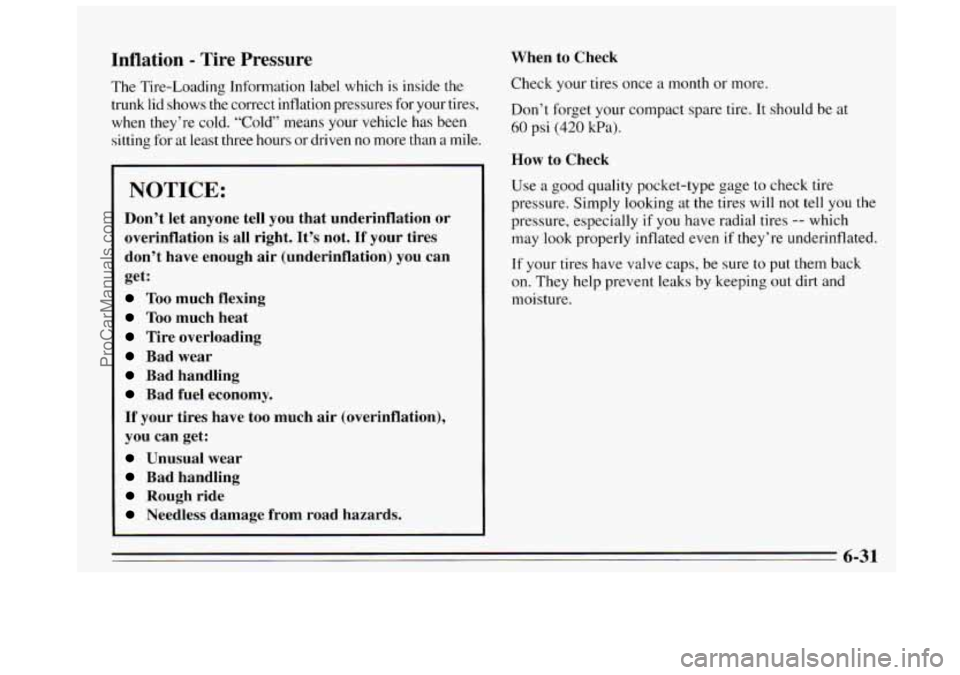
Inflation - Tire Pressure
The Tire-Loading Information label which is inside the
trunk lid shows the correct inflation pressures for your tires,
when they’re cold. “Cold” means your vehicle has been
sitting for at least three hours or driven no more than a mile.
NOTICE:
Don’t let anyone tell you that underinflation or
overinflation is all right. It’s not.
If your tires
don’t have enough
air (underinflation) you can
get:
Too much flexing
Too much heat
Tire overloading
Bad wear
Bad handling
Bad fuel economy.
If your tires have too much air (overinflation),
you can get:
Unusual wear
Bad handling
Rough ride
Needless damage from road hazards. When to Check
Check
your tires once a month or more.
Don’t forget your compact spare tire. It should be at
60 psi (420 kPa).
How
to Check
Use a good quality pocket-type gage to check tire
pressure. Simply looking at the tires will
not tell you the
pressure, especially
if you have radial tires -- which
may look properly inflated even if they’re underinflated.
If your tires have valve caps, be sure
to put them back
on. They help prevent leaks by keeping out dirt and
moisture.
6-31
ProCarManuals.com